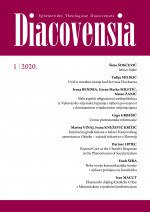Neki aspekti religioznosti srednjoškolaca iz Vukovarskosrijemske županije i njihova povezanost s dominantnim vrijednosnim orijentacijama
Some Aspects of the Religiosity of High School Students from Vukovar-Srijem County and Their Correlation with Dominant Value Orientations
Author(s): Ivana Bendra, Geran-Marko Miletić, Mateo ŽanićSubject(s): Christian Theology and Religion, School education, Present Times (2010 - today), Migration Studies
Published by: Katolički bogoslovni fakultet u Đakovu
Keywords: traditional religiosity; confessional and religious identification; religious practice; individualistic religiosity; high school students from Vukovar-Srijem County; dominant value orientations;
Summary/Abstract: The paper is based on a preliminary presentation of the research resultswithin the project Migration Aspirations and the Quality of Life of Young People in Vukovar- Srijem County, conducted by the Ivo Pilar Institute of Social Sciences in 2018/2019. The first part of the research results presented in this paper aims to highlight some aspects of the religiosity of high school students in Vukovar-Srijem County (confessional and religious self-identification, religious practice) and the consequent correlation of the level of religiosity with the observed dominant value orientations among them. The study was conducted in the period from February to March 2019 on a representative sample (N = 744) by means of a questionnaire survey of third and fourth grade students of all high schools in Vukovar-Srijem County (15 in total). The paper concludes that among high school students from Vukovar-Srijem County traditional (institutional) religiosity emerges as the dominant form of religiosity. Data show a significant proportion of respondents who identify as believers (41.1%) or who frequently attend religious ceremonies (weekly, 47.2%). The presence of an individualistic form of religiosity was observed in 25.5% of the respondents. The analysis of value orientations confirmed the presence of value pluralism among the respondents, but also found a correlation between the level ofreligiosity and the dominant value orientation.
Journal: Diacovensia: teološki prilozi
- Issue Year: 28/2020
- Issue No: 1
- Page Range: 27-54
- Page Count: 28
- Language: Croatian

